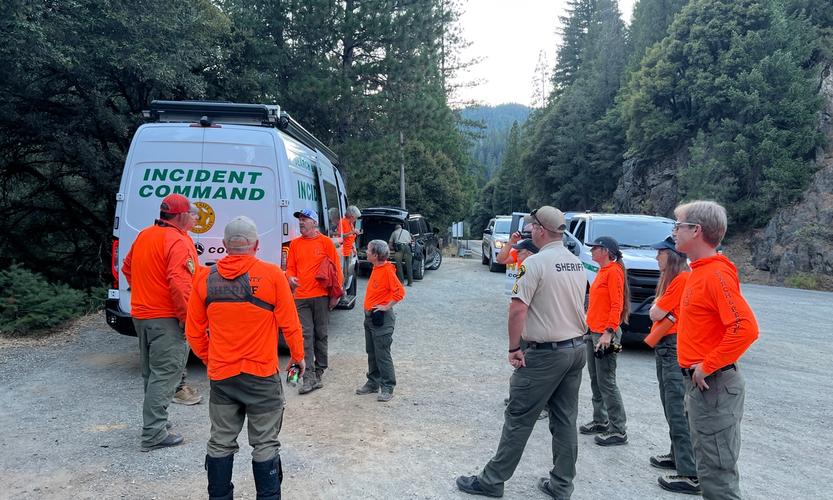Cal Fire Prepares for Summer: Enhanced Resources and AI Monitoring
May 14, 2025

Chief Brian Estes (right) Deputy Chief Jim Hudson (left) address the Nevada County Board of Supervisors.
NEVADA CITY — On Tuesday, Cal Fire Nevada-Yuba-Placer Unit Chief Brian Estes and Deputy Chief Jim Hudson gave an informational presentation at a Nevada County Board of Supervisors meeting. They shared how Cal Fire is preparing for the upcoming dry fire season and wildfires.
In 2024, Estes’ unit handled 427 wildland fires, burning 1,256 acres. Thanks to quick responses and teamwork, the total is far below the average of 2,587 acres. Estes credited “our commitment to aggressive initial attack, [and] our partnerships with our local government and federal fire agencies.” Statewide, Cal Fire is seeing more fires year-round, making the idea of a set “fire season” less relevant. “80% of our fires in this region are caused by humans,” Estes said, pointing out that accidents, negligence, and a higher-than-average rate of arson play big roles.
Estes also gave a broader update: “In 2025 already, as we sit here today, we’ve experienced over a thousand wildland fires, which really spells out why we are not in a fire season.” Across California, 16,251 structures have been lost this year, primarily from southern California fires. Over the past three years, Cal Fire has used more than 10 million gallons of fire retardant in its efforts.
Cal Fire depends on its dispatch centers, like the Grass Valley Emergency Command Center (ECC), to manage growing fire risks. The Nevada-Yuba-Placer Unit is based at the Grass Valley ECC, the third-busiest in the state after Riverside and San Diego. Last year, it managed over 39,000 9-1-1 calls and sent out 73,000 emergency responses. The center dispatches for more than 30 local fire and medical service agencies.
Estes feels good about rainfall levels for the dry season ahead, which have been 90-110% of average since last October. “I’m happy to say that as of May 1st, Nevada County, as well as Placer and Butte counties, our neighbors to the north and south are not in, um, in a drought cycle,” he noted. Southern California, however, faces much drier conditions.

Governor Gavin Newsom announced the addition of a second C-130 aircraft to the Cal Fire fleet in April.
Despite the good news in Northern California, Cal Fire keeps pushing forward. The organization continues to invest in resources and technology. With steady funding despite state budget challenges, Cal Fire has added aircraft like C-130s and Blackhawks and kept up its controlled burn programs. Cal Fire has also started using artificial intelligence (AI) in its camera systems, which Estes says has been very effective over the past year.
Cal Fire has boosted its full-time staff and now holds a 9-month peak staffing period from March 15th to December 15th. Deputy Chief Hudson explained that ground crews grew by 30% after cutting standard workweeks from 72 to 66 hours, with plans to drop to 56 hours. The shift has increased year-round staffing at Truckee, Nevada City, and Smartsville stations.
The regional unit runs 22 frontline engines, seven hand crews, four bulldozers, and several aircraft. Hudson also highlighted the camera program, with over 1,000 cameras statewide and nearly 50 in the Nevada-Yuba-Placer area. He said AI has been key in spotting fires early, noting that of 7,553 statewide fire dispatches, about 1,700 came from AI before any reports were made. Cal Fire plans to add 100 more cameras this year, with utility company PG&E set to install even more.
Featured Articles

Search Continues for Missing Goodyears Bar Resident Gil Clark →
August 18, 2025
Authorities search for missing 78-year-old Gil Clark, last seen in Downieville, as investigation continues.
Nevada County to Increase Off-Highway Patrols Labor Day Weekend →
August 26, 2025
County Explores Options for Downieville Veterans Memorial →
August 20, 2025
Kiley Introduces Bill Banning Mid-Decade Redistricting, Not Gerrymandering →
August 22, 2025
CDFW Confirms Six Wolf Pups for Sierra County Pack →
August 11, 2025